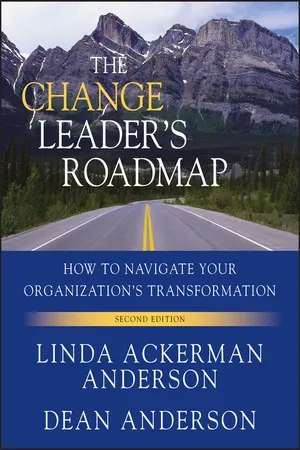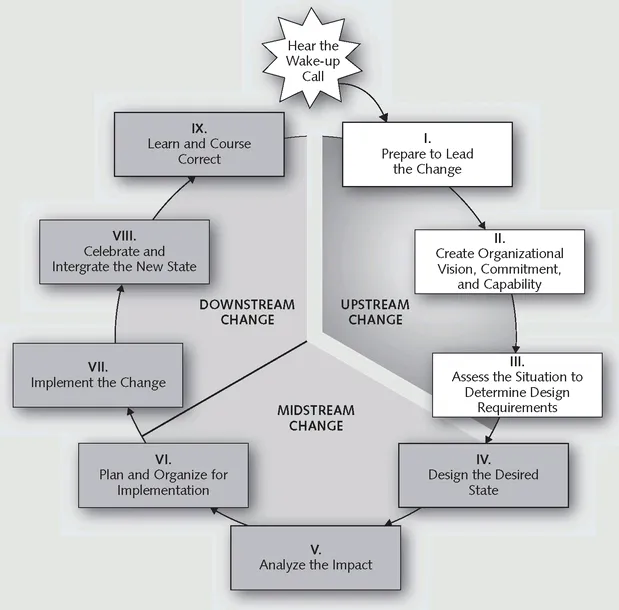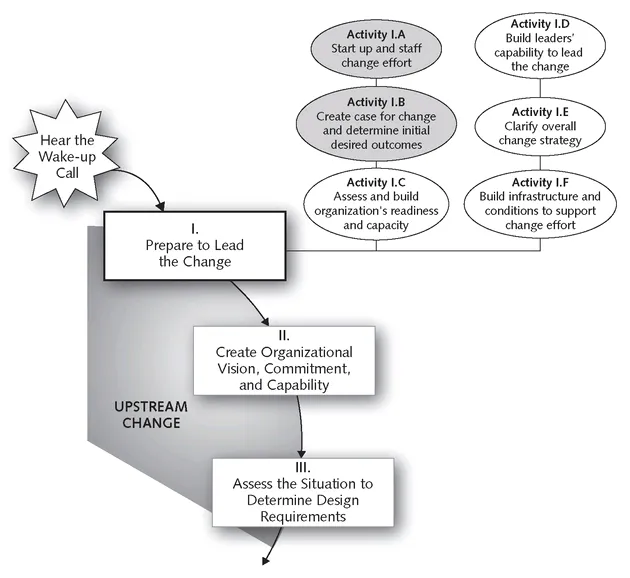![]()
SECTION 1
Upstream Change
![]()
CHAPTER 1
PHASE I
Prepare to Lead the Change: Start Up, Staff, and Create Your Case for Change
ACTIVITY I.A AND I.B: TASK DELIVERABLES
I.A.1: A project briefing has been obtained, shared, and agreed to by all key leaders.
I.A.2: Change leadership roles have been defined, and the change effort has been staffed with qualified people.
I.A.3: Effective working relationships have been established among all change leaders, and between all of the change leaders and change consultants. I.A
.4: Your project community has been identified and mobilized to support the change.
I.A.5: Your Phase I roadmap has been determined.
I.B.1: The process for creating your case for change is clear and has been staffed appropriately.
I.B.2: The drivers of your change have been determined.
I.B.3: The type of change has been clarified.
I.B.4: Leverage points for making the change have been identified.
I.B.5: An initial analysis of the organizational and human impacts of the transformation has been done.
I.B.6: The target groups of the change have been identified, and the scope of change is clear.
I.B.7: The degree of urgency for making the change has been assessed.
I.B.8: Your initial desired outcomes for the change have been determined, and the complete case for change has been prepared for communication.
The process of change actually begins the moment a person or group recognizes that there is a reason to alter how the organization and its people operate. This awareness triggers a decision process, ending in the leaders agreeing to proceed. By the time leaders decide to formally mobilize a change effort, work has already begun and information has surfaced that will affect how the leaders start up the effort. Phase I is designed for leaders to clarify where the effort is, what they are trying to accomplish, and how best to get it launched. They need to understand what is known, who is doing what, and how far along the work has progressed. Early speed and effectiveness depend on the leaders being as aware, aligned, and informed as possible.
The overall purpose of Phase I, covered in Chapters One through Four, is for the leaders of the change to establish a conscious, shared intention and strategy for a successful transformation and to prepare to lead the effort through the following:
• Clarifying change leadership roles and the status of the change effort, and staffing the effort with the right people
• Creating a clear case for change and determining their initial desired outcomes to use to inform and compel people to support the change
• Assessing the organization’s readiness and capacity to take on and succeed in the effort given everything else going on
• Strengthening leaders’ capability—individually and collectively—to understand, commit to, and model the behaviors and approaches required to lead this change successfully
• Clarifying the overall change strategy
• Designing the optimal conditions and structures for supporting the change strategy to be successful
These efforts represent the six activities of Phase I. This chapter covers the first two activities, Start Up and Staff Change Effort and Create Case for Change and Determine Initial Desired Outcomes. Before we address the work of these two activities, let’s start the action where it actually begins, with the first notion of the need for change.
HEARING THE WAKE-UP CALL
Wake-up calls are “aha moments,” awareness of an opportunity to be pursued or a threat to be removed. They can surface anywhere in the organization, at any level. At times, there is grass-roots awareness of the need long before executives take notice. However, for an organization-wide transformation to mobilize, the leaders of the organization affected must ultimately hear the signal clearly enough to warrant attention and discussion, if not action. In change-resistant organizations, executives typically do not get or heed wake-up calls until the signals become so painful and dangerous that they threaten the organization’s very survival.
The wake-up call may come in the form of a dramatic event, such as the competition beating you to market with a similar or better product; or it may be the accumulation of many small indicators that finally culminate in a loud and meaningful message. Examples of the latter include loss of market share, new technological advancements in your industry, mergers of your key competitors, the required closure of a once valuable factory, the initiation of a hostile unionization effort, or an increase in turnover of critical talent.
At this very early stage in the transformation, it is important to identify and understand what wake-up calls exist, what they mean, and what is being done with them by those in position to initiate a change effort. The mindset of the leaders has a major impact on the meaning they make of the information in the wake-up call. If the leaders are conscious and open to learning and changing, they will deal with the wake-up call differently than if they are not.
If you are consulting to the change, your initial responsibility is to assist leaders to acknowledge and respond to their wake-up calls in depth. This is the first moment of truth in the change effort; it can mean the difference between a reactive, superficial change and one that is conscious, purposeful, and able to achieve breakthrough results.
Let’s assume that, at some point, the leaders receive the right signals and have acknowledged the need to change. They will automatically create an initial case for change and scope in their minds. These informal impressions will be used later as the starting point for designing the official case for change. After the leaders have committed to launch a change effort, the process is underway, officially beginning Phase I.
PHASE I: PREPARE TO LEAD THE CHANGE
Establishing clear foundations for a successful change effort from the beginning increases the organization’s likelihood of success. Phase I and its six activities accomplish the majority of this work. Many of the tasks of these activities can be done in parallel.
Phase I is critical work for the leaders. It covers 50 to 60 percent of the decisions that will inform your change strategy and plan. It does not take that same percentage of time, but it requires that amount of upfront decision making. The leaders cannot delegate this work, although other people can be involved to help lay the groundwork for the change leaders.
Remember the television commercial where a car repairman removes himself from under the hood of a car and says to the viewer, “Well, you can pay me now, or you can pay me later.” He is referring to the fact that work must be done. You can do it now, or you can do it later; but you cannot skip it. Doing this required work upfront will undoubtedly be easier and less costly than neglecting it and dealing with the problems its absence creates downstream. In our experience, conscious leadership attention to the work of Phase I is the most powerful of all change acceleration strategies. It models the principle “Go slow to go fast” and is well worth the time and effort.
ACTIVITY I.A: START UP AND STAFF CHANGE EFFORT
Task I.A.1: Obtain Project Briefing
After the leaders decide to formally initiate their change process, it is imperative to gather and coalesce all of the existing information and opinion about the effort. The leaders need a clear picture of what is known, who has been doing what, and what the current reactions are. Without this, attempting to lead the change can be like herding cats. They need this early project briefing to ensure alignment, leverage progress, and minimize surprises.
You may find it useful to interview the various people or groups that know about the change and are going to be impacted by it to assess how they view the effort. Questions to these people usually include their knowledge of the content or focus of the change, people issues, political dynamics, or process expectations. You can ask about their knowledge about the drivers of the change, the history of the effort, perceptions of the current change events and activities underway, key issues that have arisen, and future directions. (See Premium Content: Identifying Project Briefing Questions, www.pfeiffer.com/go/anderson.) Once gathered, you would prepare this information to brief everyone who needs to know the status of the change effort at this early stage, including all consultants in the effort.
Briefing data usually reveals whether key stakeholders, including the leaders, see the change effort through the same set of lenses or whether there are potentially confusing or conflicting discrepancies in people’s perceptions. How people are talking about the change effort at this early date can be a significant predictor of how well it will be received after it gets underway. And, if leaders are not aligned, they will not be able to lead the effort effectively. Their alignment is essential.
Task I.A.2: Clarify and Staff Initial Change Leadership Roles
The second task in this activity is to determine how the transformation will be led—who is sponsoring the effort, who is designing and leading the change strategy and process design, and who is involved in various other ways. Clear roles and responsibilities are needed for all of the change leaders to minimize redundancy and ensure full coverage of change leadership responsibilities and decisions.
Because taking on a change leadership role is usually considered an addition to one’s existing duties, there are two predictable issues in staffing. The first is when these roles are assigned to people who have the most available time. Caution! Roles should be given to the people who are the most competent and best positioned to successfully lead the effort. These selections must be very strategic because your effort will either be enhanced or encumbered by these staffing selections. The second issue is that your best people are already over-committed and cannot give the change leadership role the time and attention it needs. If your best people are that busy, then you must ask yourself whether their current activities are more important than achieving the outcomes of the change. If these people are the right leaders for the change, they must free up the time to fulfill their role adequately. “Lip service” will not work.
The following sidebar presents a list of six typical change leadership roles and their deliverables. You can use all of them as described, or you may tailor them to fit the magnitude of your change effort and the resources available for it. To tailor the roles, you can use different titles and determine expanded, reduced, or different responsibilities and deliverables for each role.
CHANGE LEADERSHIP ROLES
SPONSOR
The individual with highest line authority over the change effort, “executive champion,” has primary influence over desired outcomes and breakthrough results: inputs significantly to change strategy; supports change process leader; is a member of change leadership team; sets boundary conditions and design requirements; approves desired future state solution, including cultural imperatives; ensures conditions for success are named and supported; keeps the transformation in alignment with overall business; delivers major communications; requires key course corrections to be surfaced and made; acknowledges benchmark successes during the process and sets standards for breakthrough results; maintains ongoing links with major stakeholders; models the desired culture, mindset, and behavior required by the transformation.
DELIVERABLES: • Achievement of the organization’s business strategy through the creation and oversight of the change strategy, initiatives, and conditions required to produce business outcomes and breakthrough results
• Mobilization and alignment of entire organization undergoing change
• Clear direction and path for change, clear expectations for results
• Sustained well-being in the organization during and after change
• Being a model of the mindset, behavior, and cultural changes required for success and...




